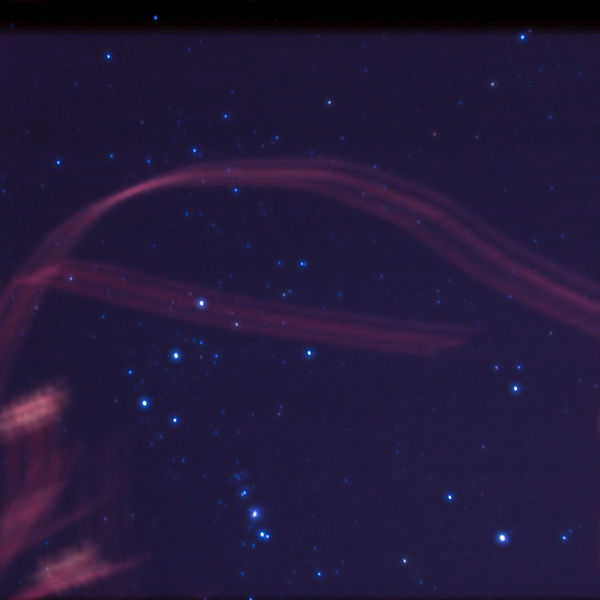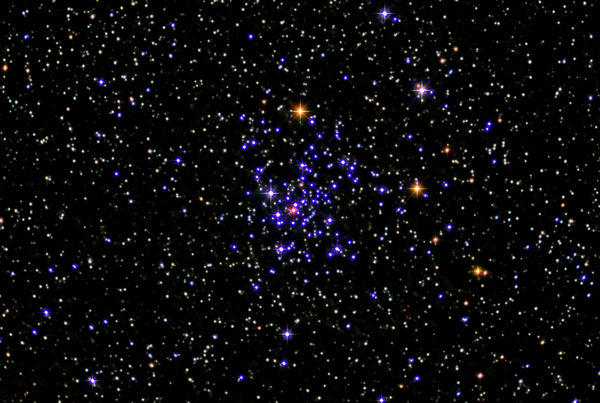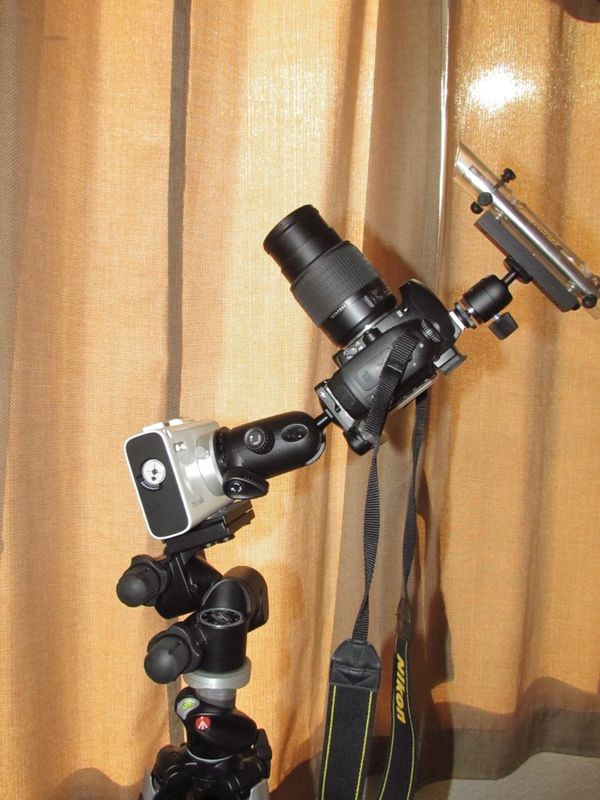As far as I can go so far in astrophotography
Mar 4, 2013 21:49:01 #
It's trails and Orion Constellation. I have tried my Polarie but i don't think I am setting it correctly or it is not moving. I put my ear to the Vixen and I hear something moving, so I guess it is but when I see several of the pictures the stars are not in the same place so it is not tracking, right? This is a test with different timings up to 30 secs, only 8 shots. Even though they were not in the same place I aligned all the photos with Lynkeos (Mac). I use Crossover to use DSS but ends up crashing and telling me there is not enough memory (8Gb RAM, Intel dual processor iMac). Anyway, here it is.

Mar 5, 2013 16:46:05 #
Aldebaran wrote:
It's trails and Orion Constellation. I have tried ... (show quote)
First for the crash, close all other programs before starting stacking programs, this will "sometime" get rid of the not enough memory problem.
Second, if you are using just the mount alone and not using some means of a guider, such as a second telescope coupled with a guide camera, your limit usually is about 30 second exposures. With a guide system setup one can track on stars (theoretically) indefinately. Most astrophotographers take 5 to 10 minute exposures then stack. Hope this helps.
Mar 5, 2013 18:39:15 #
I am no expert. I too am trying to figure out how these things work, but this is my understanding of the situation, and I would be interested in finding out if this is correct.
The Vixen Polarie Star Tracker, like the Ioptron Skytracker, is a tracking device with a small built-in motor, and involves no telescope at all. It is mounted on a camera tripod with a ball head and the camera then mounted to it via another ball head. Both brands need to be aligned with Polaris to begin with, then should track until the batteries run out, which is quite a long time. I have had my eye on them, but am tending towards the Ioptron. If the device was correctly aligned I don't see why it wouldn't track properly, unless there is a malfunction. I don't have one and have never used one, but I believe there is more than one speed setting; perhaps you need a different one. But I am completely baffled by those reddish trails when the stars are not showing any trailing.
With a film camera you can have a single exposure as long as you want - you just let the film gather all the light it needs. But with a digital camera you need to take a series of shorter exposures and then use a stacking program to combine them. Otherwise the sensor overheats - is that right? The question is how long the exposures should be, and whether you need an interval between exposures, and, if so, how long. This is something I would like to know more about. Then there are those dark frames and flat frames, complete mysteries to me.
It would be good to hear from Polarie/Ioptron users on this.
The Vixen Polarie Star Tracker, like the Ioptron Skytracker, is a tracking device with a small built-in motor, and involves no telescope at all. It is mounted on a camera tripod with a ball head and the camera then mounted to it via another ball head. Both brands need to be aligned with Polaris to begin with, then should track until the batteries run out, which is quite a long time. I have had my eye on them, but am tending towards the Ioptron. If the device was correctly aligned I don't see why it wouldn't track properly, unless there is a malfunction. I don't have one and have never used one, but I believe there is more than one speed setting; perhaps you need a different one. But I am completely baffled by those reddish trails when the stars are not showing any trailing.
With a film camera you can have a single exposure as long as you want - you just let the film gather all the light it needs. But with a digital camera you need to take a series of shorter exposures and then use a stacking program to combine them. Otherwise the sensor overheats - is that right? The question is how long the exposures should be, and whether you need an interval between exposures, and, if so, how long. This is something I would like to know more about. Then there are those dark frames and flat frames, complete mysteries to me.
It would be good to hear from Polarie/Ioptron users on this.
Mar 5, 2013 20:45:25 #
Straight Shooter wrote:
I am no expert. I too am trying to figure out how ... (show quote)
I have several mounts including an iOptron. They all track pretty good but there are several things that do need to be mentioned. First unless one spends a tremendous amount of money for a top notch mount you won't have super accurate tracking. This is not much of a problem with short focus lenses but does begin to show up when one exceeds 300 to 400 mm focal length. All mounts suffer from what is known as periodic error and this is usually what causes the small trailing in Right Ascension (east-west movement). The more expensive the mount the less periodic error (most of the time). Second, another source of trailing is inaccurate polar alignement. This can cause star trails drifting north or south (Declination). It can be corrected by accurate polar alignement which can be difficult to achieve with long focal length lenses. This is the reason seasoned astrophotographers use guide scopes and guide ccd cameras. I just returned from Namibia Africa and used a small Celestron CG-5 mount to take photographs with. Accurate polar alignement in the southern hemisphere is very difficult as they have no pole star to center on as we do. I was using a 72mm diameter telescope at f/6, or 432mm focal length. I had a Canon T2i camera attached to the telescope, my exposures were usually 15 seconds with a 7 second gap between exposures. Typically when using 15 second exposures I would take 40 exposures and stack them giving me a roughly 10 minute exposure. The attached image was taken with this setup , 15 second exposures, 40 exposures total, ISO 1600. Used Deep Sky Stacker for the stacking program and processed with Photoshop Elements 9. It was summertime in Namibia with temps typically ranging 90 to 110 degrees yet I had no problem with overheating of the camera. A friend of mine uses a guidescope with ccd guide camera and takes 5 minute exposures through the same set up I use. He stacks 12 images giving the equivalent of a 1 hour exposure and does not have any heating problems. Digital images have the advantage of being able to stack them and making a long exposure using shorter ones to avoid guiding errors, aircraft trail, satellite trails etc. Film on the other hand suffers from reciprocity failure and are very difficult to stack, I know, been there seen it, done it. I used film back in the 60's onward until the advent of the digital age.
As for the photo that was posted, I haven't the foggiest idea what the reddish trails are, possibly insects flying in front of the camera lens??? I'm at a loss for that. I hope this helps somewhat, if it doesn't, please get back to me and I'll try to clarify any questions you may have. Please do not let my explanations deter you from trying astrophotography, it may be somewhat difficult to learn/understand but the rewards are nice once one gets the hang of it.
NGC 2516

Mar 6, 2013 10:22:33 #
Algol wrote:
quote=Aldebaran It's trails and Orion Constellati... (show quote)
I use a Polarie for longer shots which I am learning to align and use. Just beginning. What I have "learned": Alignment is critical, yes, and difficult if you cannot see Polaris like i do because I have too many obstructions! the perfect use of the Polaris depends on alignment, mostly. I don't think that the Polarie Can go as long as 10 minutes, it has a weight limit of 4.4 lbs on top of it (camera, lens and head) but I can take many photos and stack, theoretically. The lens focal lens determines how long you can track without trails as I have read on different forums where they toss formulas around, but is that a correct science? BTW: I had not heard of camera heating before.

Mar 6, 2013 12:36:33 #
Aldebaran wrote:
quote=Algol quote=Aldebaran It's trails and Orio... (show quote)
You should be able to take 30 second exposures with your setup. Try taking as many 30 seconed exposures as possible then stack them. Alignment is critical, there is another metod of alignment called drift method, it can be done photographically but takes time and patience. You can look it up on the internet and get detailed directions on how to do it. The best way I can tell you is to experiment with various focal lengths and exposure times until you find the longest exposure without trailing as you can do. As for heating, that produces noise as you expose the camera for longer durations. This is the reason that most all CCD cameras that are used for astronomical purposes have a cooling unit built into the camera. Some can get you down to as low as 65 degrees below ambient temperature. Others such as the high end CCD's will have a water cooled system that used in conjunction with the normal cooling methods will get your temperatures down even further. Professional astronomers use liquid nitrogen to cool their cameras down.
Mar 6, 2013 13:36:46 #
I am struggling here to get a "workable" image. ;-( And my camera for the test was not the best, a circa 2005 Nikon DSLR ... Sigh! Not until I get alignment right will I try to use a better camera.
Sep 17, 2013 22:04:00 #
It's been a lon time since this post and I am trying my luck again at the Polarie. I am hoping for better weather and nights during the winter. I know people use it with great results, In stargazers.com I have seen great posts with the Polarie when they align well, which I KNOW I AM NOT DOING. The process is cumbersome. So I know it is me... BTW: The "red trails" are branches from a willow swinging in front of the lens, not trails. I think they look rather nice.
If you want to reply, then register here. Registration is free and your account is created instantly, so you can post right away.


